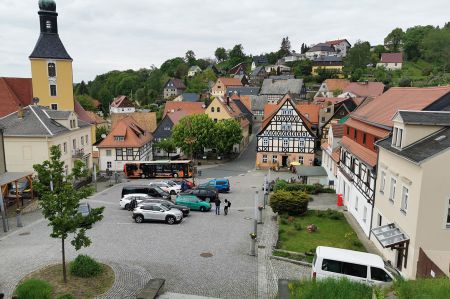From the Bastei Bridge to Hohnstein - hello to Kasper
- Written by Portal Editor
After our recent visit to the Bastei Bridge, we also wanted to visit the town of Hohnstein, especially Hohnstein Castle as an attraction and Friends of Nature House and as a starting point for hiking and climbing tours in the Saxon Switzerland National Park.
We had heard too often about the hiking tours through the Polenztal, because only three kilometres south of Hohnstein is the Brandaussicht, 177 meters above the Polenztal, and the Märzenbecher meadows in the Polenztal are a special attraction for numerous hikers in spring.
The Hohnstein puppet stage and carving workshop
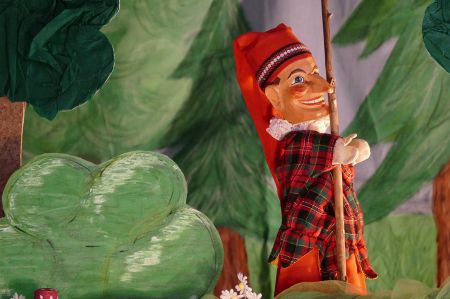 The puppet theatre and Hohnsteiner Kasper, who had their first performance in the castle in 1928 and later resided in a Kasperhaus provided by the city, are also named after the town and Hohnstein Castle.
The puppet theatre and Hohnsteiner Kasper, who had their first performance in the castle in 1928 and later resided in a Kasperhaus provided by the city, are also named after the town and Hohnstein Castle.
The name Hohnstein is thus closely linked to the puppet theatre "Die Hohnsteiner" that Max Jacob founded in the early 1920s as part of the Wandervogel movement.
Later, three more Hohnsteiner Puppenbühnen were formed whose headquarters were no longer in Hohnstein itself.
Max Jacob and Friedrich Arndt in particular made "Die Hohnsteiner" known worldwide through film, television, sound recordings, literature and mass-produced hand puppets.
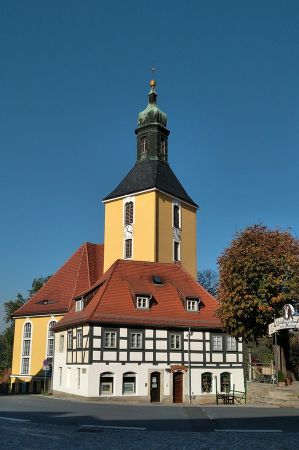 Today there is no longer a Hohnsteiner stage. However, numerous imitative traveling theatres boast the Hohnsteiner name.
Today there is no longer a Hohnsteiner stage. However, numerous imitative traveling theatres boast the Hohnsteiner name.
However, the Hohnsteiner hand puppet workshop is still located in Hohnstein.
After the death of Theo Eggink, the creator of numerous hand puppets and the Kaspertheater ensemble, first Gerhard Berger and then his son Wolfgang took over the carving workshop, which shipped the Hohnsteiner puppets all over the world.
Castle complex – a rather inglorious complex of buildings
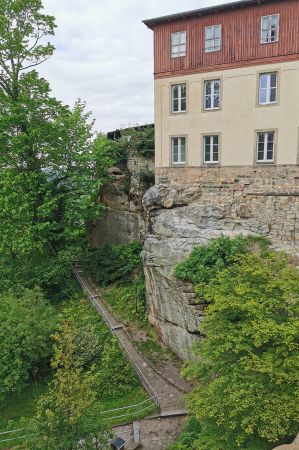 Tourism gained in importance at the beginning of the 20th century, but the first visitors to Saxon Switzerland had been visiting Hohnstein since 1850.
Tourism gained in importance at the beginning of the 20th century, but the first visitors to Saxon Switzerland had been visiting Hohnstein since 1850.
The mighty Hohnstein Castle complex was used from 1933 as one of the early concentration camps (KZ Hohnstein) during the National Socialist era.
Around 5,600 prisoners, including 109 women and 400 youths, were imprisoned there. They were used for extremely hard forced labour in the Heeselicht quarry.
Several communists and social democrats died here as a result of being tormented by members of the SA, and some took their own lives. From the beginning of the Second World War, the castle served as a prison camp (Oflag) for 800 Polish and then French officers, later as Stalag IV-A for Yugoslavian and Soviet prisoners of war.
Elbe sandstone - a hiking landscape for the soul
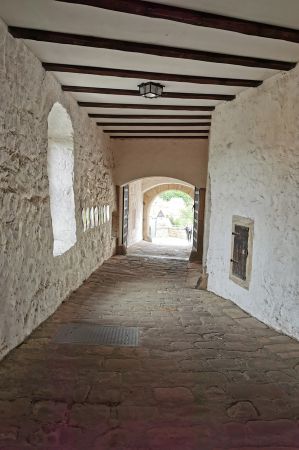 Hiking is probably best described as immersing yourself in the tranquillity of nature. Here Hohnstein can be considered a starting point for countless romantic paths and climbs that lead through the sometimes mystical landscape.
Hiking is probably best described as immersing yourself in the tranquillity of nature. Here Hohnstein can be considered a starting point for countless romantic paths and climbs that lead through the sometimes mystical landscape.
Every view reveals an overwhelming panorama of rocks and forests, valleys and gorges, plains and expanses. In the Hohnsteiner Tälerland contrasts of wide views and deep gorges, steep climbs and relaxed forest paths meet.
From a relaxing walk to a challenging hike, everything is possible here. Only three possible routes are mentioned here:
1. Bastei tour
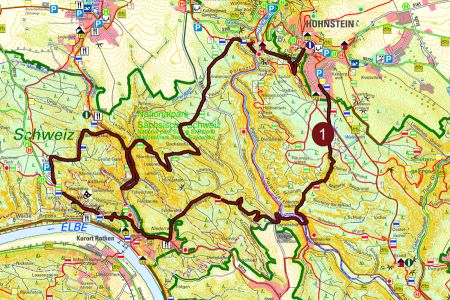 The hike starts from the Hohnstein town hall in the direction of Polenztal and first passes the remains of the wall of the old bear garden. After the descent via the Schindergraben, the ascent to the Hockstein takes place via the Wolfsschlucht. From there it goes over the node path to the Amselsee and over the Schwedenlochen to the Bastei. This is followed by the descent to the spa town of Rathen. The way back to Hohnstein leads via the Füllholzelweg back to the Polenztal and the ascent to Hohnstein via the Neuweg.
The hike starts from the Hohnstein town hall in the direction of Polenztal and first passes the remains of the wall of the old bear garden. After the descent via the Schindergraben, the ascent to the Hockstein takes place via the Wolfsschlucht. From there it goes over the node path to the Amselsee and over the Schwedenlochen to the Bastei. This is followed by the descent to the spa town of Rathen. The way back to Hohnstein leads via the Füllholzelweg back to the Polenztal and the ascent to Hohnstein via the Neuweg.
Trail markers: Blue line - Green line - Blue line - Red line
Hiking time: about 6 hours
Difficulty level: persistent and exhausting
2. Polenztal and Brand prospect
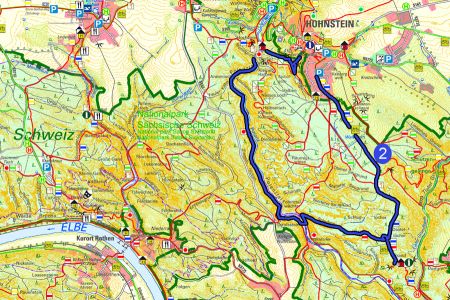 From the Hohnstein town hall, the tour leads past the remains of the wall of the old bear garden over the Schindergraben down into the Polenztal. It continues downstream through the 80 meter high Felsental to the Waltersdorfer Mühle. From there the ascent takes place via the Schulzengrund and the Brandstraße to the Brandaussicht with its unique view. It then takes you comfortably back to Hohnstein via the Brandstrasse.
From the Hohnstein town hall, the tour leads past the remains of the wall of the old bear garden over the Schindergraben down into the Polenztal. It continues downstream through the 80 meter high Felsental to the Waltersdorfer Mühle. From there the ascent takes place via the Schulzengrund and the Brandstraße to the Brandaussicht with its unique view. It then takes you comfortably back to Hohnstein via the Brandstrasse.
Trail markers: Blue line - Red dot - Red line - Blue line
Hiking time: about 2.5 hours
Difficulty level: short and moderately strenuous
3. Waitzdorfer view and Napoleonschanze
 From the Hohnstein town hall, take the Halbenweg past the Gautschgrotte along the Malerweg to the Brandaussicht. From there, the descent takes place over 800 fire steps into the Tiefen Grund and over the Dorfgrund 650 steps up to Waitzdorf. A path loop at the end of the village leads to the Waitzdorfer prospect. Back in the village, it's worth making a detour to the Waitzdorferhöhe with its unique view. The way back goes below the Waitzdorfer Berg past the Galloway herd via the Holländerweg back down into the Tiefen Grund and up again on the opposite side. The hike leads along the Lupinenweg to the Napoleonschanze and from there back to Hohnstein.
From the Hohnstein town hall, take the Halbenweg past the Gautschgrotte along the Malerweg to the Brandaussicht. From there, the descent takes place over 800 fire steps into the Tiefen Grund and over the Dorfgrund 650 steps up to Waitzdorf. A path loop at the end of the village leads to the Waitzdorfer prospect. Back in the village, it's worth making a detour to the Waitzdorferhöhe with its unique view. The way back goes below the Waitzdorfer Berg past the Galloway herd via the Holländerweg back down into the Tiefen Grund and up again on the opposite side. The hike leads along the Lupinenweg to the Napoleonschanze and from there back to Hohnstein.
Trail markings: green line - blue line - red line - unmarked - yellow – Green Dash
Hiking time: 5.5 hours
Difficulty level: persistent and exhausting
Please read as well:
Paddling on the Unstrut - from Roßleben to Kirchscheiden
Kate Clow - Lycian Trail and Others
-
 Hohnstein - Hiking Tours awaiting you
Hohnstein - Hiking Tours awaiting you
Hohnstein - Hiking Tours awaiting you
Hohnstein - Hiking Tours awaiting you
-
 Hohnstein - Hiking Tours awaiting you
Hohnstein - Hiking Tours awaiting you
Hohnstein - Hiking Tours awaiting you
Hohnstein - Hiking Tours awaiting you
-
 Hohnstein - Hiking Tours awaiting you
Hohnstein - Hiking Tours awaiting you
Hohnstein - Hiking Tours awaiting you
Hohnstein - Hiking Tours awaiting you
-
 Hohnstein - Hiking Tours awaiting you
Hohnstein - Hiking Tours awaiting you
Hohnstein - Hiking Tours awaiting you
Hohnstein - Hiking Tours awaiting you
-
 Hohnstein - Hiking Tours awaiting you
Hohnstein - Hiking Tours awaiting you
Hohnstein - Hiking Tours awaiting you
Hohnstein - Hiking Tours awaiting you
-
 Hohnstein - Hiking Tours awaiting you
Hohnstein - Hiking Tours awaiting you
Hohnstein - Hiking Tours awaiting you
Hohnstein - Hiking Tours awaiting you
https://www.alaturka.info/en/hiking-tours/6124-from-the-bastei-bridge-to-hohnstein-hello-to-kasper#sigProIdec7abb2ee5
